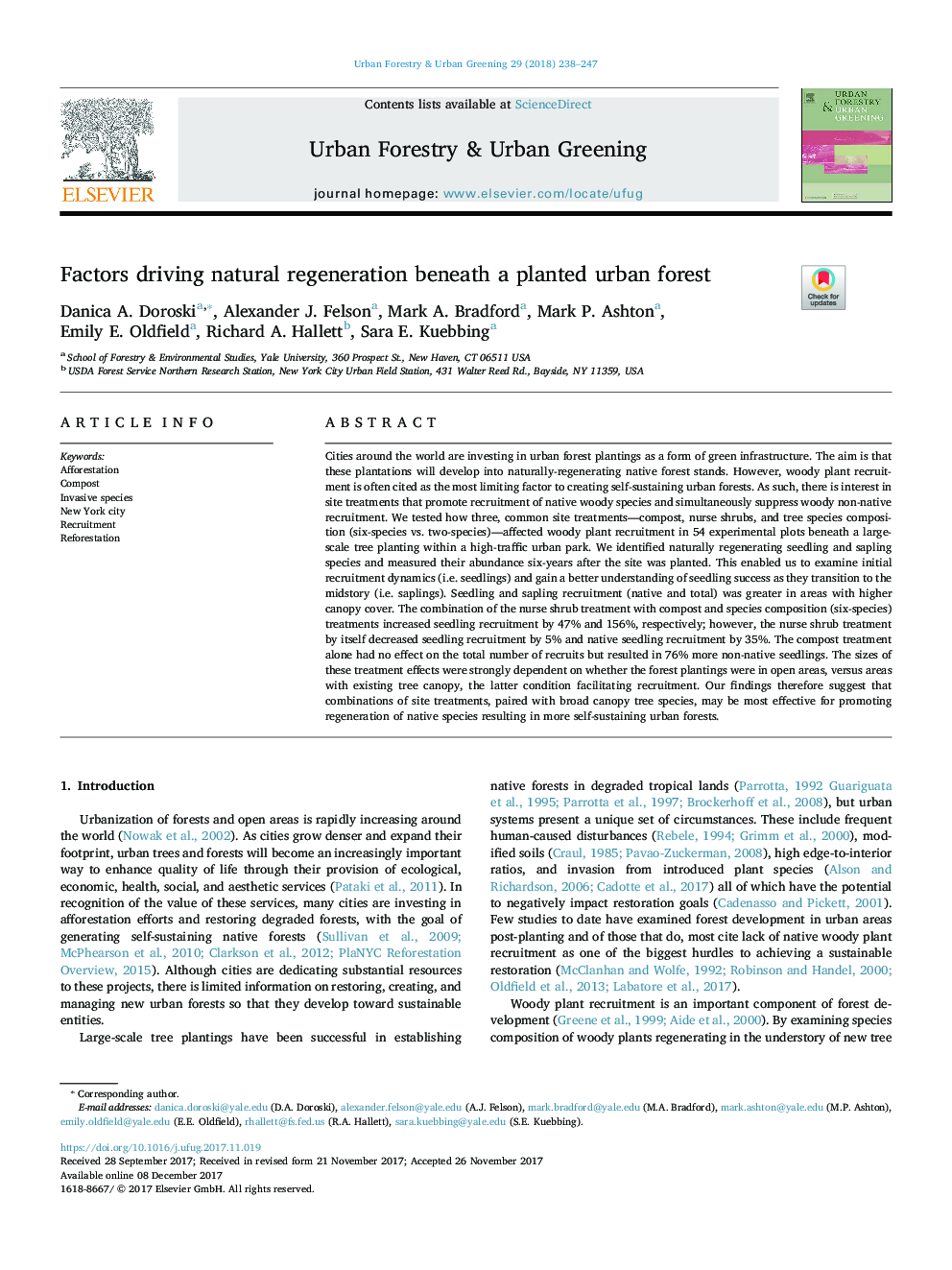| کد مقاله | کد نشریه | سال انتشار | مقاله انگلیسی | نسخه تمام متن |
|---|---|---|---|---|
| 6549478 | 1421861 | 2018 | 10 صفحه PDF | دانلود رایگان |
عنوان انگلیسی مقاله ISI
Factors driving natural regeneration beneath a planted urban forest
ترجمه فارسی عنوان
عوامل رانندگی طبیعی در زیر جنگل های کاشته شده شهری
دانلود مقاله + سفارش ترجمه
دانلود مقاله ISI انگلیسی
رایگان برای ایرانیان
کلمات کلیدی
جنگل زراعی، کمپوست، گونه های مهاجم، شهر نیویورک، استخدام، جنگل زدایی،
ترجمه چکیده
شهرستانها در سراسر جهان سرمایه گذاری در کاشت جنگل های شهری به عنوان یک شکل از زیرساخت های سبز. هدف این است که این گیاهان به سواحل جنگلی بومی طبیعی بازسازی شوند. با این حال، استخدام گیاهان جنگلی اغلب به عنوان عامل محدود کننده برای ایجاد جنگل های شهری پایدار به شمار می رود. به این ترتیب، علاقه به درمان های سایت وجود دارد که باعث جذب گونه های چوب بومی شده و به طور همزمان استخدام غیر بومی چوب خزنده را مهار می کند. ما تست شده بودیم که چگونه سه گونه گیاه درمان مشترک، کمپوست، بوته پرستار و ترکیب گونه های درختی (شش گونه در مقایسه با دو گونه) جذب گیاهان جنگلی در 54 قطعه آزمایشی در زیر کاشت درخت در مقیاس بزرگ در یک شهر پرجمعیت پارک ما به طور طبیعی گیاهچه های اصلاح شده و گونه های نهال را شناسایی کردیم و فراوانی آنها را شش سال پس از کاشت بوته اندازه گیری کردیم. این امر ما را قادر می سازد تا دینامیک استخدام اولیه (یعنی نهال ها) را بررسی کنیم و درک بهتر موفقیت های گیاهچه را به عنوان میان وحشی (یعنی نهال ها) انتقال دهیم. استخدام نهال و نهال (بومی و کل) در مناطقی با پوشش سایبان بالاتر بود. ترکیبی از روش کاشت پرستار با ترکیب کمپوست و ترکیب گونه (شش گونه) به ترتیب 47 و 156 درصد افزایش یافت. با این حال، درمان بوته پرستار به تنهایی باعث کاهش جذب گیاهچه 5٪ و جذب گیاهچه های بومی 35٪ شد. درمان کمپوست به تنهایی بر تعداد کل کارکنان تأثیری نداشت اما باعث شد 76٪ بیشتر نهال های غیر مادری شود. اندازه این اثرات درمان به شدت وابسته به اینکه آیا کاشت جنگل در مناطق باز، در مقابل مناطق با سقوط درخت در حال حاضر، وضعیت اخیر تسهیل در استخدام. یافته های ما نشان می دهد که ترکیبی از درمان های سایت، همراه با گونه های درختی گسترده ای می تواند برای ترویج بازتولید گونه های بومی که منجر به جنگل های بیشتر در معرض جنگل های شهری می شود، موثر باشد.
موضوعات مرتبط
علوم زیستی و بیوفناوری
علوم کشاورزی و بیولوژیک
جنگلداری
چکیده انگلیسی
Cities around the world are investing in urban forest plantings as a form of green infrastructure. The aim is that these plantations will develop into naturally-regenerating native forest stands. However, woody plant recruitment is often cited as the most limiting factor to creating self-sustaining urban forests. As such, there is interest in site treatments that promote recruitment of native woody species and simultaneously suppress woody non-native recruitment. We tested how three, common site treatments-compost, nurse shrubs, and tree species composition (six-species vs. two-species)-affected woody plant recruitment in 54 experimental plots beneath a large-scale tree planting within a high-traffic urban park. We identified naturally regenerating seedling and sapling species and measured their abundance six-years after the site was planted. This enabled us to examine initial recruitment dynamics (i.e. seedlings) and gain a better understanding of seedling success as they transition to the midstory (i.e. saplings). Seedling and sapling recruitment (native and total) was greater in areas with higher canopy cover. The combination of the nurse shrub treatment with compost and species composition (six-species) treatments increased seedling recruitment by 47% and 156%, respectively; however, the nurse shrub treatment by itself decreased seedling recruitment by 5% and native seedling recruitment by 35%. The compost treatment alone had no effect on the total number of recruits but resulted in 76% more non-native seedlings. The sizes of these treatment effects were strongly dependent on whether the forest plantings were in open areas, versus areas with existing tree canopy, the latter condition facilitating recruitment. Our findings therefore suggest that combinations of site treatments, paired with broad canopy tree species, may be most effective for promoting regeneration of native species resulting in more self-sustaining urban forests.
ناشر
Database: Elsevier - ScienceDirect (ساینس دایرکت)
Journal: Urban Forestry & Urban Greening - Volume 29, January 2018, Pages 238-247
Journal: Urban Forestry & Urban Greening - Volume 29, January 2018, Pages 238-247
نویسندگان
Danica A. Doroski, Alexander J. Felson, Mark A. Bradford, Mark P. Ashton, Emily E. Oldfield, Richard A. Hallett, Sara E. Kuebbing,
